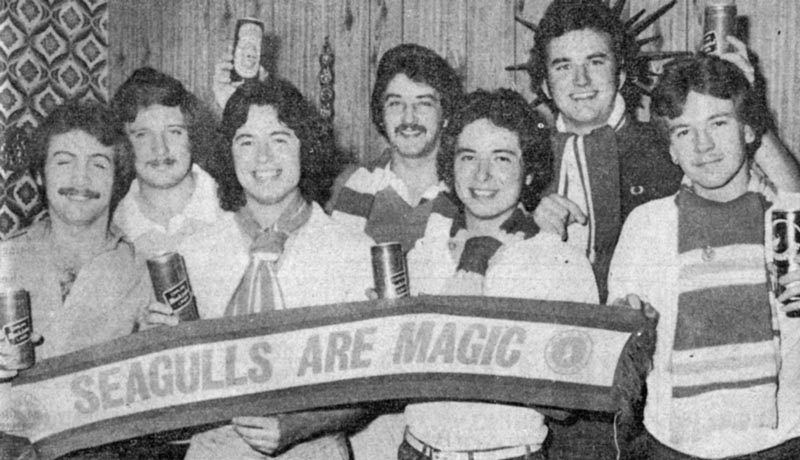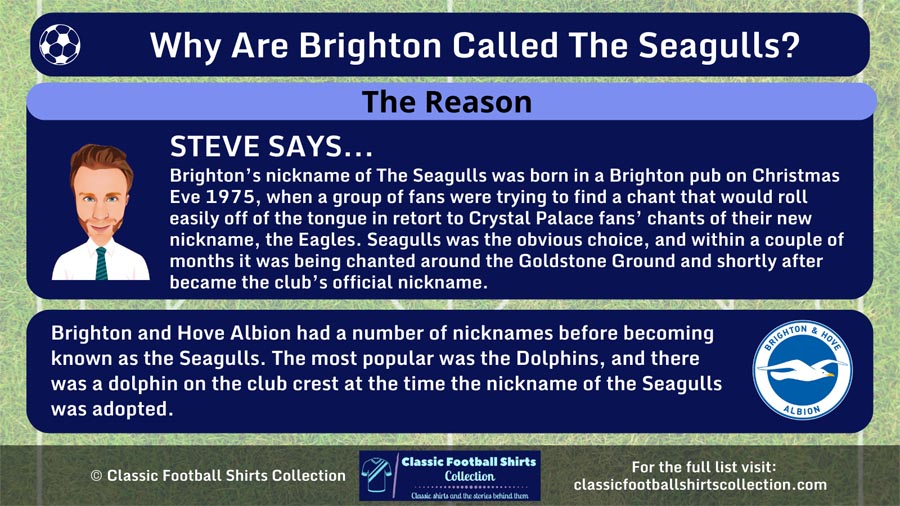
I never realised that Brighton only adopt its nickname relatively recently.
Well recently considering the club was formed in 1901.
For more than seven decades they were known by other nicknames.
So why are Brighton called the Seagulls?
Let’s step back to Christmas Eve 1975 and find out…
Why Are Brighton Called The Seagulls?
Brighton’s nickname of The Seagulls was born in a Brighton pub on Christmas Eve 1975, when a group of fans were trying to find a chant that would roll easily off of the tongue in retort to Crystal Palace fans’ chants of their new nickname, the Eagles. Seagulls was the obvious choice, and within a couple of months it was being chanted around the Goldstone Ground and shortly after became the club’s official nickname.

The Club With No (Nick)Name
For a long time, Brighton and Hove Albion were a club without a real nickname.
In the early days they were known, unimaginatively, as The Albion and slightly more ingeniously as The Lambs.
The later nickname apparently came from the lambs who would graze on the club’s Goldstone Ground pitch in the early days of the club’s history.
Pre-war it was said the club’s nickname was ‘The Shrimps’, yet no one can ever recall this being the case and even club director and lifelong Brighton fan Derek Chapman has confirmed the club was never known as the Shrimps.
The lack of a favoured nickname was so prominent that in 1950 the Brighton Evening Standard started a competition to find one.
A number of ideas were suggested, including the Dolphins, the Holidaymakers and the Seasiders.
The winner though was the obvious ‘The Brovions’…
The new nickname was officially announced at the Goldstone Ground on 9 December 1950.
It was remembered for all of two minutes before fans carried on using the Albion as a nickname.
RELATED ===> Revealed: The Best Retro Brighton Shirts
The Dolphins
And that is how things went on until 1972 when the club again recognised the need for a nickname that would be adopted by the fans.
An appeal was made in the Brighton Evening Argus for fans to again send in suggestions for a new nickname.
This time the list the club received was a little longer and included the Coasters, Mariners, Royals, Sovereigns, Swifts, Seagulls and Marlets.
But there was one choice that was a lot more popular than all the others.
The Dolphins.
The name had added credence due to the opening of a Dolphinarium in the city in 1969.
Built at a cost of £250,000 (around £3.5million in today’s money), it was a major attraction and the board was quick to recognise this.
The nickname was taken up straight away, and a new badge was designed for the 1974/75 season incorporating a dolphin.
Still no sign of the Seagulls yet right?
That was soon about to change…
The Seagulls!

On Christmas Eve 1975 a group of Brighton fans was out in the city celebrating Christmas. The group included Derek Chapman, who would become a director of the club in 1999.
Sat around a table in the Bo’sun pub in West Street, a popular haunt for Brighton fans, the friends recalled a game three months earlier when they had travelled to promotion rivals Crystal Palace.
Despite winning 1-0, they had been outsung by their opponents as Jeff Wells, who was in the group, admitted in a report in the Brighton Argus at the time.
“At Selhurst Park the Palace supporters started chanting ‘Eagles’ and the volume was so loud that we could not sing anything louder than them” he said.
Whilst the nickname at the time of the Dolphins was far from unpopular, it didn’t roll off the tongue easily.
RELATED ===> Why Are Crystal Palace Called The Eagles?
Over another pint the group looked out of the window to see a familiar sight in Brighton, a few seagulls scavenging for food.
It was a lightbulb moment, the Seagulls was much easier to chant, as the group demonstrated that evening.
Soon the whole pub joined in, and just a couple of months later the terraces were picking up on it as well.
Derek Chapman, future club director said: “We didn’t really mean to give Albion a nickname. All we were trying to do was have a go at Palace and find a chant that could drown their fans.”
And that they most certainly did.
On 24 February 1976, Crystal Palace travelled to the Goldstone Ground as both teams battled for promotion.
A packed crowd of 33,000 Brighton fans met Palace’s ‘Eagles’ with a retort of ‘Seagulls’.
Unlike the previous meeting that season the Crystal Palace fans were out-chanted and out-sung.
Like the previous meeting, Brighton and Hove Albion won.
Unfortunately, neither team would gain promotion that year. Brighton finished 4th and Palace finished 5th, level on points and just outside the promotion zone.
The following season both Brighton and Palace gained promotion to the Second Division finishing second and third.
Two seasons later Crystal Palace won the Second Division and Brighton were runners up, and both were promoted to England’s top division for the 1979-80 season.
By then Brighton and Hove Albion were well and truly known as the Seagulls.
Final Thoughts

So Brighton’s nickname took inspiration from Crystal Palace, who themselves had only just adopted the nickname of the Eagles, having previously been known as the Glaziers.
A mere three years after being ‘officially’ nicknamed the Dolphins the club was now becoming more popularly known by supporters as the Seagulls.
This did leave the commercial side of the club with somewhat of a problem, a new badge and a whole stockroom full of new Dolphin-related memorabilia had to go!
That it did, and in 1977, after just three years, the dolphin was replaced by a seagull on the club badge.
It coincided with the most successful period in the club’s history at that point, as they gained promotion to the First Division in 1979 for the first time ever.
They would spend four seasons in the top flight and also reach their first (and to date only) FA Cup Final in 1983 during that time.
The Seagulls had soared!
